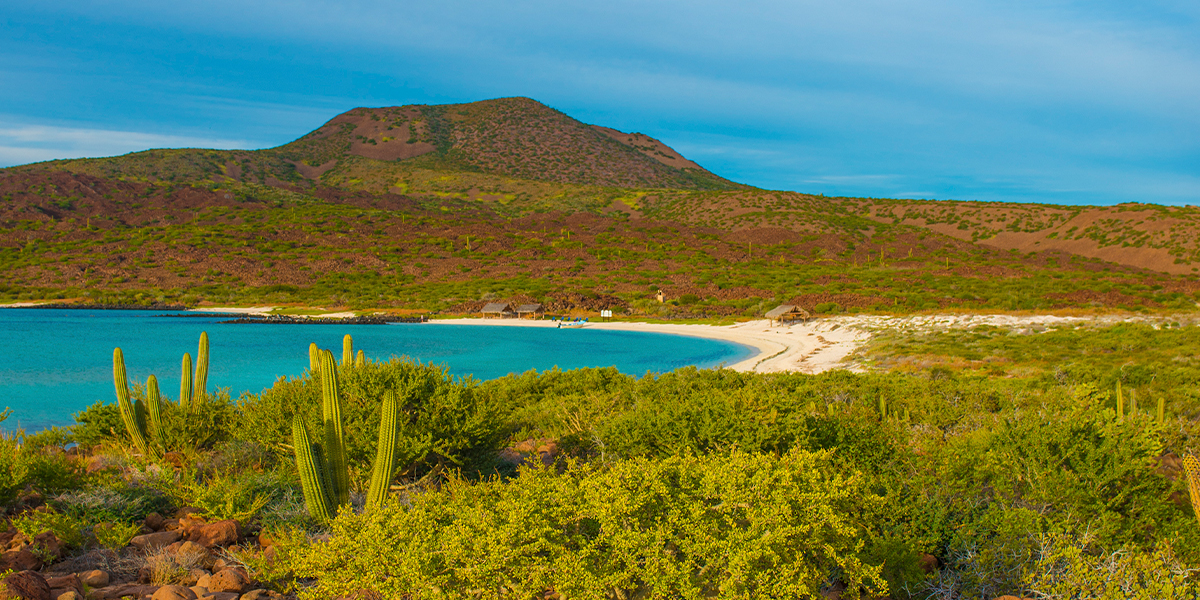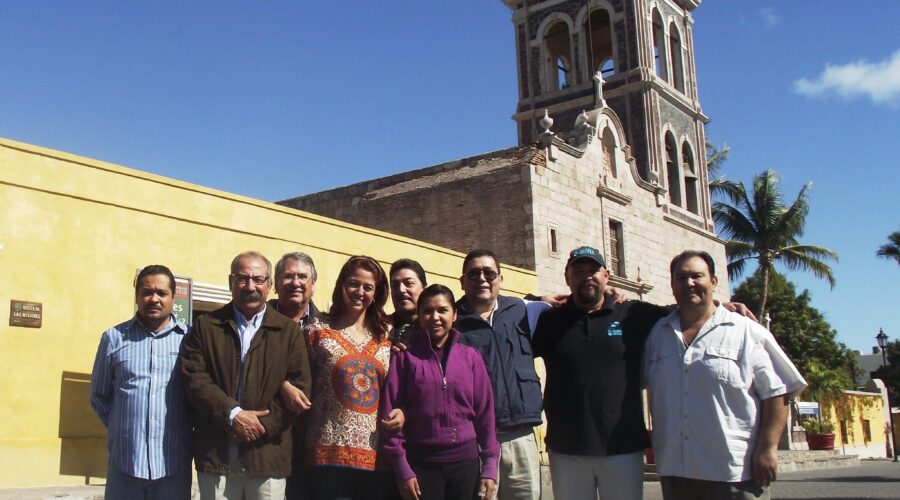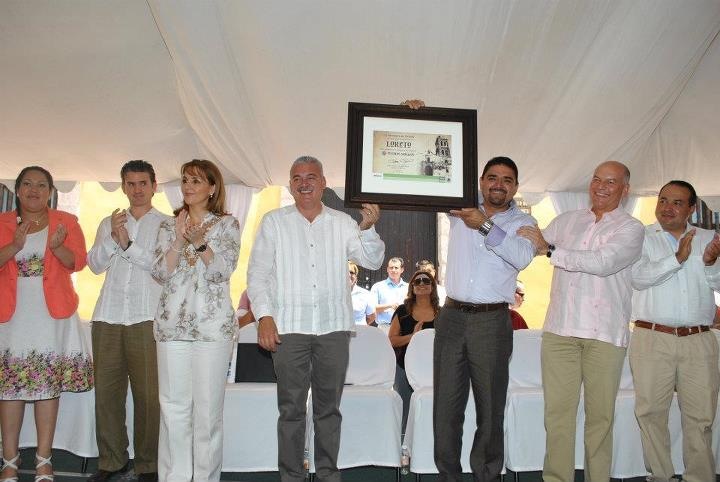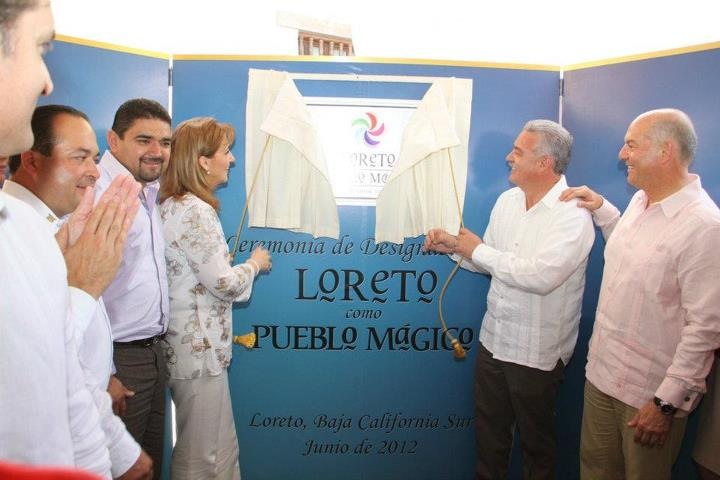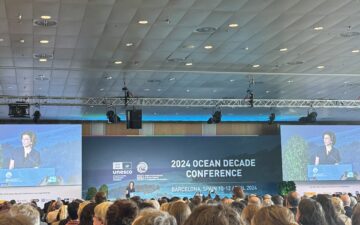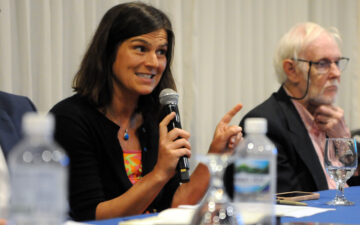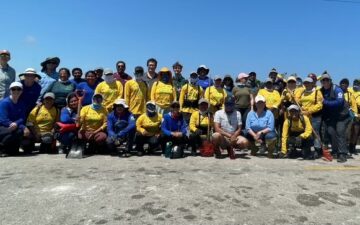Loreto, Baja California Sur
We at The Ocean Foundation have a long-standing relationship with the municipality of Loreto in Baja California Sur, Mexico. My name is Mark J. Spalding and I am the President of The Ocean Foundation. I first visited Loreto in about 1986, and have been blessed to visit there one or more times per year since. In 2004, we were honored to be asked to create the Loreto Bay Foundation to receive 1% of gross sales from the sustainable green resort development known as the Villages of Loreto Bay. We operated this specially branded foundation as a subsidiary of The Ocean Foundation for nearly 5 years. During this time, my visits included working with local grantees on many different aspects of this community. For more details you can see the 2004 to 2009 summary in the Loreto Bay Foundation section below.
Today, Loreto is much better off than it might have been otherwise, as a result of the sustainable development model, and the contributions to the community as a whole that came from that real estate development through our foundation. However, we are also seeing recent movements to start mining within the boundaries of the municipality; such activities are arguably inconsistent with the town’s ecological ordinance, particularly as it relates to the protection of extremely scarce water resources in the desert. All of this is discussed in more detail in the sections below.
I hope you learn to enjoy this small town in Mexico through this resource page, as much as I have for over 30 years. Please come visit Pueblo Mágico Loreto.
LORETO BAY NATIONAL MARINE PARK
The Loreto Bay National Park (1966) is a protected natural area of Mexico and consists of the Bay of Loreto, the Sea of Cortez and part of Baja California Sur. The park has a wide variety of marine environments, attracting more marine mammals than any other Mexican National Park and, is one of the most visited parks in the country.
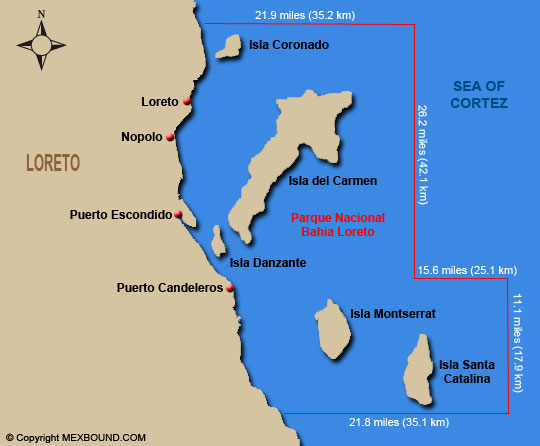
UNESCO World Heritage Designation
UNESCO World Heritage Convention is an international agreement intended to protect natural and cultural heritage. In this case, Mexico applied and was awarded UNESCO World Heritage Status in 2005 for the Loreto Bay National Marine Park, which means this location is of special cultural or natural importance to the common heritage of humanity. Once added to the list, an obligation of each nation that is a party to the Convention is created to ensure the protection, conservation, and transmission to future generations of the cultural and natural heritage so listed. Hence, it goes beyond being an obligation of just the Mexican government to protect this park. There are 192 nation states who are parties to the Convention, making it one of the most adhered to international agreements. Only Liechtenstein, Nauru, Somalia, Timor-Leste, and Tuvalu are not Parties to the Convention.
RARE Pride Campaign 2009-2011
Rare’s Loreto Bay Campaign for Sustainable Fisheries Management was a two-year campaign that empowered local fishers in Mexico to practice sustainable fishing practices and inspired their communities to support conservation as a way of life.
Loreto Bay Keeper
In the fall of 2008, the Executive Director of Eco-Alianza was elected to serve as the Loreto Baykeeper. The Waterkeeper Alliance provides the Loreto Baykeeper important technical and legal water protection tools, national and international visibility, and connections with other water protection advocates necessary to ensure vigilant protection of Loreto’s watershed.
Flora and Fauna
Loreto Bay National Marine Park is home to:
- 891 fish species, including 90 endemic fishes
- a third of the world’s cetacean species (found in the Gulf of California/Sea of Cortez)
- 695 vascular plant species, more than in any marine and insular property on the World Heritage List
“Acuerdo por el que se expide el Programa de Ordenamiento Ecológico Marino del Golfo de California.” Diaro Official (Segunda Sección) de Secretaria De Medio Ambiente Y Recursos Naturales. 15 dic. 2006.
Mexican government document dictating the natural marine management of the Gulf of California. This document is extensive and includes the breakdown of specific management procedures as well as detailed maps of the area.
“Loreto Bay National Park and it’s Marine Protected Areas.” Comunidad y Biodiversidad, A.C. and Loreto Bay National Park.
An overview of the Park written for fisherman on park zoning and how they can use it, value it and protect it.
“Mapa De Actores Y Temas Para La Revisión Del Programa De Manejo Parque Nacional Bahia De Loreto, B.C.S.” Centro De Colaboración Cívica. 2008.
An independent assessment of the current management of the Loreto Bay National Park along with recommendations for improvement. Includes a useful map of the actors and issues relevant to the overall goal of the National Park.
“Programa De Conservación Y Manejo Parque Nacional.” Booklet. Comisión Nacional De Áreas Naturales Protegidas.
A booklet of the Park for public audiences, formatted as 13 common questions and answers about the Park.
“Programa De Conservación Y Manejo Parque Nacional Bahía De Loreto México Serie Didáctica.” Cartoon illustrated by Daniel M. Huitrón. Dirección General de Manejo para la Conservación de Áreas Naturales Protegidas, Dirección del Parque Nacional Bahía de Loreto, Dirección de Comunicación Estratégica e Identidad.
An illustrated comic in which a tourist obtains information about Loreto Bay National Marine Park from a park worker and local fisherman.
PUEBLO MAGICO
The Programa Pueblos Mágicos is an initiative led by Mexico’s Secretariat of Tourism to promote a series of towns around the country that offer visitors a “magical” experience – by reason of their natural beauty, cultural riches, or historical relevance. The historical town of Loreto has been established as one of Mexico’s Pueblos Magicos since 2012. Interested tourists click here.
A video about the town of Loreto and its special presence in Baja California Sur.
Where is Loreto?
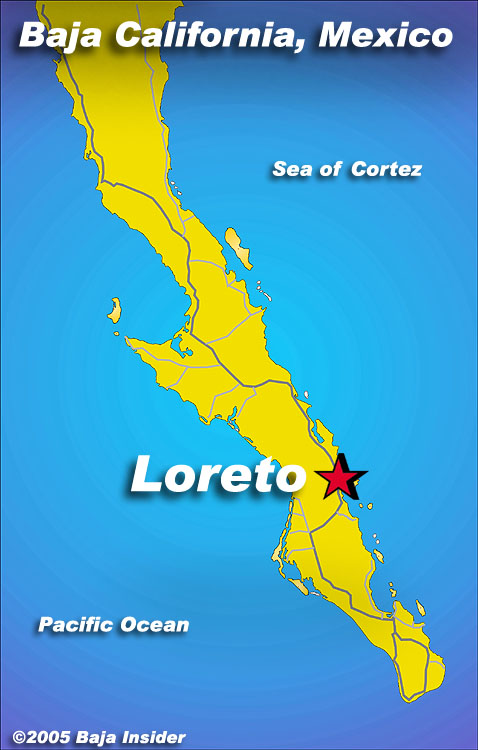
Photos from the official designation of Loreto as a “Pueblo Magico” in 2012.
Loreto: Un Pueblo Mágico
A two-page summary on the city of Loreto’s people, culture, natural resources, threats and solutions by The Ocean Foundation. Click here for the summary in Spanish.
Miguel Ángel Torres, “Loreto Sees the Limits of Growth: Slow and Steady Wins the Race,” Americas Program Investigative Series. International Relations Center. 18 Mar 2007.
The author looks into the growing pains of Loreto as a small remote town that the government desires to be developed into a main tourist destination. Loretanos (residents) actively participate in the decision making, pushing for slower, more thought out development.
Proyecto De Mejoramiento Urbano Del Centro Histórico De Loreto No. Contrato: LTPD-9701/05-S-02
The Executive Summary of the urban plan for the Loreto’s historic center.
Reporte del Expediente Loreto Pueblo Magico. Programa Pueblos Mágicos, Loreto Baja California Sur. October 2011.
A plan for local development of Loreto, to make it a sustainable destination through eight development criteria. This was part of the effort to make Loreto a “Pueblo Magico” in 2012.
“Estrategia Zonificación Secundaria (Usos y Destinos del Suelo).” Created in 2003.
Urban Planning Map for Loreto 2025.
Nopolo/Villages of Loreto Bay
In 2003, Canadian developers partnered with the Mexican government to embark on a $3 billion project, aiming to build a series of eco-friendly villages along the seaside of Loreto Bay, Mexico. The Loreto Bay Company aimed to convert a 3200-acre property on the Sea of Cortez into 6,000 sustainable residences. This green development project aims to be a model for sustainability with wind and solar power generation to produce more energy than they consumed, desalinate water to reduce their impact on local water resources, biologically treat their sewage, and so on. To foster local recreational and medical facilities, Loreto By Co. donates 1% of gross home sales to the Loreto Bay Foundation.
In 2009, about four years into an ambitious plan that would see the construction of over 500 homes (and that was just phase one), the developer filed for bankruptcy. However, the vision of new urbanism, sustainability, and a walkable community did not disappear when financial challenges struck. The community members who believed in this new way of living in this special place have kept the dream alive and well. The benefits of grants made by the Loreto Bay Foundation, as well as the fulfillment of design promises, xeriscaping, and water management have been maintained by the Homeowners Association such that Loreto is a healthier and more stable community that many others like it around the world.
Click here for the “Photo Gallery” of the Villages of Loreto Bay.
Loreto Bay Company Sustainability
- Inaugural Report 2007: 35 pages
- Report for Print
- Report for Print – Spanish
- Loreto Bay Sustainable Development FAQ
Petition for the creation of the Nopolo Natural Park
The original Canadian developers of “The Villages of Loreto Bay” promised that from the total 8,000 acres of this master plan, 5,000 acres would be restored and protected in perpetuity. This petition serves to give the park official designation that could be of municipal, state or federal order.
Parkin, B. “Loreto Bay Co. Sustainable or Greenwashing?” Baja Life. Issue 20. Pages 12-29. 2006.
A great article on the context of Loreto as a tourist destination and background on what sustainable tourism means. The author challenges Loreto Bay Company in its claim to sustainability and finds that the main concern is scale.
Stark, C.” Loreto Bay: 6 Years Later.” Stark Insider. 19 Nov 2012.
A blog from a resident family of the Loreto Bay Community.
Tuynman, J. and Jeffrey, V. “The Loreto Bay Company: Green Marketing and Sustainable Development.” Corporate Strategy and the Environment, IRGN 488. 2 Dec 2006.
An detailed assessment of the Loreto Bay Company’s plan to develop a sustainable Mexican resort, at the scale of 6,000 residences for tourists to Loreto.
Loreto Bay Foundation
In 2004, The Ocean Foundation worked with the Loreto Bay Company to help set up the Loreto Bay Foundation to ensure sustainable development and to invest 1% of gross sales of real estate in the Villages of Loreto Bay back into the community of Loreto. The partnership provides funds for local conservation, sustainability, and long-term positive community relations.
From 2005-2008 the Loreto Bay Foundation received nearly $1.2 million dollars from sales, as well as additional gifts from individual local donors. The development has since been sold, halting revenues into the Foundation. However, there is a strong demand by Loreto residents to see the Foundation revived and its work continued.
This video highlights the grants given to the community of Loreto by the Loreto Bay Foundation from 2004-2008.
Loreto Bay Foundation Annual Reports
(Mailing address, phone number and URLs in the reports are no longer valid.)
- 2004 to 2009 Summary [English and Spanish]
- 2004 [English]
- 2005 [English]
- 2006 [English and Spanish]
- 2007 and 2008 [English and Spanish]
- Loreto Bay Frequently Asked Questions
Conservation Science Symposium – Baja California.
Results from the Conservation Science Symposium held in Loreto, Baja California Sur in May 2011. The goal was to promote the exchange of information and increase collaboration between scientists, governmental representatives and conservationists of the Baja California peninsula and the Gulf of California.
Developer’s Guide to Sustainable Coastal Development in Baja California Sur 2009. Compiled by Dirección de Planaeción de Urbana y Ecologia Baja California Sur, the Loreto Bay Foundation hosted by the Ocean Foundation, and Sherwood Design Engineers. 2009.
The Loreto Bay Foundation commissioned Sherwood Design Engineers to perform research, field reconnaissance, interviews, and the creation and implementation of these development standards. Coastal Standards continue to play a role in the technical resolutions of giving permits in the Office of Planeación Urbana y Ecologia del Gobierno del Estado de BCS.
- Here is the Spanish version of the report.
- Here is an easily skimmable, visual summary of their results.
Spalding, Mark J. “How MPAs, and Best Fishing Practices Can Enhance Sustainable Coastal Tourism.” Presentation. 10 July 2014
Summary of the above presentation.
Spalding, Mark J. “Sustainability and the Example of Loreto Bay.” Video presentation. 9 November 2014.
Mark Spalding, President of The Ocean Foundation, visited Loreto Bay in Baja Sur on November 9, 2014, to speak on “Sustainability and the Example of Loreto Bay”. Click here for the follow-up Q&A.
Baja California Flora and Fauna
Baja California provides a spectacularly unique landscape and ecosystem for a diverse range of flora and fauna. The Baja California Desert occupies most of the Mexican states of Baja California Sur and Baja California. In combination with the extensive coastline of the sea and mountains, the area is home to several interesting species, including the world’s largest cactus and migratory grey whales.
Flora
About 4,000 plant species are known in Baja California, 700 of which are endemic. The combination of desert, ocean and mountains foster the growth of unusual plants that can adapt to harsh conditions.Learn more general information about the flora of Baja California here.
Especially prevalent in the region are cacti of all shapes and sizes, earning the desert the name of “Cactus Garden of Mexico.” They play an extremely important role in the ecosystem, providing food and shelter for many of the animals in the desert. Learn more about the cacti here.
This website is dedicated to the plant life, the flora, of the Baja California states of Mexico and related islands. Users can search among nearly 86,000 specimens from the San Diego Natural History Museum herbarium as well as six other herbaria including the two major institutions of Baja California and Baja California Sur.
Fauna
Desert, mountainous and marine species can all be found in Baja California. More than 300 bird species flourish here. In the water one can find schools of hammerhead sharks and pods of whales and dolphins. Learn more about the fauna of Baja California here. Learn everything you need to know about reptiles in the region here.
Water Resources
The stress on water supplies in Loreto has always been an issue in such an arid climate. Paired with increasing development and growing tourism, the concern for access to potable water is a major concern. Sadly, to make matters worse, numerous proposals are being made to start mining within the municipality. And, mining is a voracious user and polluter of water.
Water Management Challenges In The Loreto Region. Prepared by Sherwood Design Engineers. December 2006.
This paper investigates next steps for effectively managing Loreto’s water resources as well as the best practices of desalination technology in providing additional potable water sources within the context of the Loreto Urban Development Plan. They advise that before investing in a desalinization plant, improvement needs to be made on the current management and infrastructure related to water. In Spanish.
Ezcurra, E. “Water Use, Ecosystem Health and Viable Futures for Baja California.” Biodiversity: Vol 17, 4. 2007.
A look into the historical use and misuse of water in Baja California. It includes methods to improve the management of water resources, as well as how NGOs and funders can become involved.
Programa De Ordenamiento Ecológico Local Del Municipio De Loreto, BCS. (POEL) Prepared by the Center for Biological Investigations for the Government of the State of BCS Secretariat of Environment and Natural Resources. Aug 2013.
The local environmental ordinance, POEL, makes Loreto one of only a few municipalities in all of México to have established municipal statutes regulating activities based on environmental criteria.
Mining in Loreto
The Baja California peninsula is a land rich in minerals, something that has not gone unnoticed. Mining poses a serious threat to the region, already stressed for water and a general lack of resources. In addition to using scarce water for screening, washing, and flotation of mined materials, the threats include contamination from spills, cyanide, and leaching as well as the threat of abandoned mines, erosion, and rainfall on tailings dams. Effects on biodiversity, local water sources, and downstream marine systems are most concerning for communities of Baja California Sur.
Despite this, since March 2010 there has been an ongoing effort of under-informed ejido (communal farm) members and ex-government officials to aggregate their land and sell it for the purpose of a large scale mining exploitation on the part of Grupo Mexico, among other well-funded mining interests. Grupo Mexico has the largest known copper reserves in the world and is Mexican owned and operated.
Anti-mining campaign video created by The Ocean Foundation.
A campaign video about mining in Baja California and Mexico from Jovenes en Video.
Relevant Organizations
- Initiative for Responsible Mining Assurance (IRMA)
- Servicio Geológico Mexicano (BCS, Mexico Mining By Location)
- AIDA
- Frente Común por la Defensa de Loreto AC
- La Frente Ciudadano en Defensa del Agua y la Vida – (a collective of 37 organizations in BCS, of which Loreto Bay is a part)
- Earthworks
Relevant Mining Entities
Exhibit A Mining Concessions in Loreto. 20 Jan 2015.
The information contained in this Exhibit A has been obtained directly from the files of the Mining Public Registry, according to the files registered on or before January 20, 2015. “Concesiones de agua para la empresas.”
CONAGUA, Registro Público de Derechos de Agua (REPDA), dic. 2014.
Map of the National Commission of Water – mining water concession in Mexico by each company. In some towns there is more water for mining than for the people ie. Zacatecas.
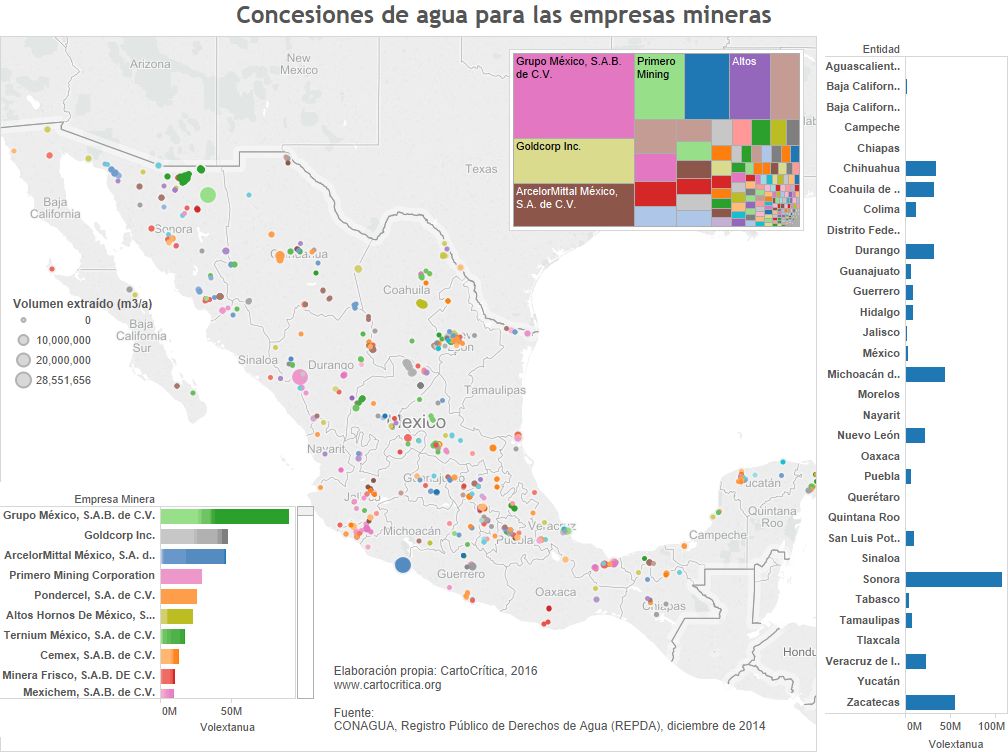
Recent News
- Semple, K. “Grassroots Anti-corruption Drive Puts Heat on Mexican Lawmakers.” New York Times. 28 May 2016.
- Flores, V. “En Puebla, 440 concesiones mineras ‘a cielo abierto’; devastan biodiversidad.” Angulo7. 27 may 2016.In Puebla, 440 mining concession for the open-pit will devestate biodiversity
- Castillo, K. “El estado omite información sobre plan minero y extractivo, acusan.” e-consulta.com 24 may 2016Mexican government accused of omitting information about mining plans.
- Ortiz, A. “Violencia: El Precio Del Oro En Guerrero.” Bajo Palabra. 19 may 2016.Violence is the price of gold in Guerrero, as people are being displaced in name of the gold mine.
- Ramirez, E. “Mineras: Acaparadoras, Contaminantes y Evasoras Fiscales.” ContraLínea.com.mx 8 may 2016.Includes a list of 20 mining operators in Mexico.
Reports
Ali, S., Parra, C., and Olguin, C.R. Análisis del Desarrollo Minero en Baja California Sur: Proyecto Minero Los Cardones. Centre for Social Responsibility in Mining. Enero 2014.
A study by the Centre for Responsible Mining finds that the Los Cardones mining project has very low potential to bring environmental , social and economic benefits to the region of Baja California Sur.
Executive Summary in English.
Cardiff, S. The Quest for Responsible Small-Scale Gold Mining: A Comparison of Standards of Initiatives Aiming for Responsibility. Earthworks. Feb 2010.
A report that compares common and leading principles from seven organizations in promoting minimal impacts from small-scale gold mining.
Dirty Metals: Mining, Communities and the Environment. Report by Earthworks and Oxfam America. 2004.
This report highlights that metal is everywhere and the sourcing of it via mining is often harmful to both communities and the environment.
Gudynas, E. “Why We Need an Immediate Moratorium on Gold Mining.” Americas Program. 16 May 2015.
Mining is growing at a faster pace than ever, too fast for humanitarian and legal issues to be assessed and dealt with.
Guía de Procedimientos Mineros. Coordinación General de Minería. Secretaría de Economía. Mar 2012.
A guide to mining procedures to provide basic and up-to-date information about the requirements, procedures, agencies and institutions Involved in mining activities and costs.
Ibarra, Carlos Ibarra. “Antes De Salir, El Pri Aprobó En Loreto Impuesto Para La Industria Minera.” Sdpnoticias.com. 27 Oct. 2015.
A news article announcing that the last act of the former Mayor of Loreto, Jorge Alberto Aviles Perez, was to create a rural lands tax to recognize use by the mining industry.
Letter to UNEP re: Mount Polley and Mexico mine waste spills. Earthworks. 31 Aug 2015.
A letter to the UNEP from several environmental organizations, urging them to implement and enforce stricter mining regulations, in reaction to the disaster at Mount Polley mining dam in Canada in 2014.
“Loreto Mining Controversy.” Eco-Alianza de Loreto, A.C. 13 November 2015.
A great overview of the mining controversy in Loreto from Eco-Alianza, environmental organization based in the area.
Prospectos Mineros con Gran potencial de desarrollo. Secretaría de Economía. Servicio Geológico Mexicano. September 2012.
A report and description of nine mining projects bidding for the ability to mine in Mexico as of 2012. Loreto is among them.
Repetto, R. Silence is Golden, Leaden, and Copper: Disclosure of Material Environmental Information in the Hard Rock Mining Industry. Yale School of Forestry & Environmental Studies. July 2004.
Known material environmental risk information and uncertainties must be disclosed in financial reports by publicly traded mining companies. This report summarizes ten specific environmental events in this context, and reviews how and when mining companies have failed to disclose risks.
Saade, C.L., Velver, C.P., Restrepo, I., and Angulo, L. “La nueva minería en Mexico.” La Jornada. Aug-Sept 2015.
Special multi-article edition of La Jornada looks at mining in Mexico
Spalding, Mark J. “The Current Status of Mining Tax in Loreto.” 2 Nov 2015.
Spalding, Mark J. “Mining in Baja California Sur: Is It Worth the Risk?” Presentation Deck. 16 April 2015.
A 100 page deck about the mining issue in Loreto, including the environmental impact, the governance involved and maps of the proposed areas.
Sumi, L., Gestring, B. Polluting the Future: How Mining Companies Are Contaminating Our Nation’s Water in Perpetuity. Earthworks. May 2013.
A report that highlights the perpetual presence of mining, long after an operation has completed, especially when it concerns drinking water. It includes a table of mining operations known to perpetually pollute, likely to pollute or predicted to pollute in the United States.
Tiffany & Co. Corporate Responsibility. 2010-2014.
Tiffany & Co., a jewelry brand recognized globally, leads the industry in advocating for environmentally sound practices. The company sets standards for itself that rise far above industry standards, refusing to mine areas of high ecological or cultural value.
Troubled Water: How Mine Waste Dumping Is Poisoning Our Oceans, Rivers, and Lakes. Earthworks and MiningWatch Canada. Feb 2012.
A report that looks into the waste dumping practices of several mining organizations, and includes eleven cases studies of specific bodies of water threatened by contamination.
Vázquez, D.S. “Conservación Oficial y Extractivismo en México.” Centro de Estudios para el Camobio en el Campo Mexicano. Octubre 2015.
An investigative report on the protected areas and natural resource extraction in Mexico, with extensive mapping to illustrate the overlap.
Zibechi, R. “Mining is Bad Business.” The Americas Program. 30 Nov 2015.
A short report on the string of complications, environmental liabilities, social polarization and loss of governmental legitimacy that have to do with mining in Latin America.
Zibechi, R. “Mining in Decline: An Opportunity for the Peoples.” 5 Nov 2015.
Report on the state of mining in Latin America. The mining industry has taken a dip in Latin America, and the resulting decrease in profits, is compounded by society’s growing resistance to its environmental and social impacts.
Spalding, Mark J. Report on Mining Threat in Baja California Sur, Mexico. The Ocean Foundation. November 2014.
This report serves as an update (November 2014) on the current status of mining in Baja California Sur for stakeholders, donors and investors in order to evaluate how imminent of a threat copper mining represents.
Spalding, Mark J. “Can Water Protect Us from Mining?” Submission for Loreto LIFE. 16 Sept 2015.
Water is used in mining operations to wash ore, making it contaminated and no longer usable. In Loreto, where water is already a scarce resource, the threat of mining poses a huge risk for the entire community.
Current situation and perspectives for water resources and environmental manager in Loreto, BCS. March 2024. A report on the quality of water and sanitation services in Loreto overall. In Spanish.
- Report Annexes: In English minus Annex 4 (Annex 4a, 4b, 4c, 4d); In Spanish (complete)
Mining News Archive
“Mineras consumen el agua que usarían 3 millones de mexicanos en tres años, dicen académicos.” SinEmbargo.mx 4 may 2016.
A study reveals that mining companies in the sector consume the same water vital to more than 3 million people a year.
Birss, M. and Soto, G.S. “In crisis, we find hope.” Nacla. 28 April 2016.
An interview with activist Gustavo Castro Soto on the assassination of world-renowned Honduran environmental and indigenous rights activist Berta Cáceres.
Ancheita, A. “In Defense of Human Rights Defenders.” Medium. 27 April 2016.
Alejandra Ancheita is the founder and executive director of ProDESC, the Project on Economic, Social, and Cultural Rights. In this article she calls for global leaders to protect human rights activists in response to the death of Berta Cáceres.
“Latin American NGOs Ask Canada to Clean Up its Mining Act Abroad.” Frontera Norte Sur. 27 abr 2016.
“Positiva la Recomendación de Ombudsman nacional sobre Áreas Naturales Protegidas.” CEMDA. 27 abr 2016.
Ombudsman links human rights to protected areas.
“Organizaciones latinoamericanas envían carta a Trudeau para exigir mayor responsabilidad a mineras.” NM Noticias.CA. 25 abr 2016.
NGOs send letter to Trudeau about Canadian mining companies.
Valadez, A. “Ordenan desalojar por seguridad a familias que rehúsan dejar sus casas a minera de Slim.” La Jornada. 8 abr 2016.
Zacatecas land evictions for families refusing to leave homes to Slim mine.
León, R. “Los Cardones, punta de lanza de la minería tóxica en Sierra de la Laguna.” La Jornada. 3 abr 2016.
MAS environmental group warns Los Cardones only beginning for mining
Ibarra, C. “Los Cardones, la mina que no quiere irse.” SDPnoticias.com. 29 mar 2016.
Los Cardones, the mine that won’t go away.
Ibarra, C. “Determina Profepa que Los Cardones no opera en La Laguna; exigen revisar 4 zonas más.” SDPnoticias.com. 24 mar 2016.
PROFEPA says not Los Cardones doing illegal work near Sierra la Laguna
“Graves amenazas sobre el Valle de los Cirios.” el Vigia. 20 mar 2016.
Serious mining threat for Valle de los Cirios.
Llano, M. “Concesiones de agua para las mineras.” Heinrich Boll Stiftung. 17 feb 2016.
Interactive map water concessions for mining in Mexico. Find map here.
Ibarra, C. “Minera que operó ilegalmente en BCS, solicitó permiso ante Semarnat.” SDPnoticias.com. 15 dic 2015.
Mining company shut down for illegal operation in Vizcaino applies for permit.
Domgíuez, M. “Gobierno Federal apoyará a comunidades mineras de Baja California Sur con 33 mdp.” BCSnoticias. 15 dic 2015.
Federal fund set up to support mining communities in BCS
Día, O. “Empresas mineras ven como atractivo de México la debilidad de sus leyes: Directora Conselva.” 25 oct 2015.
Mining companies see Mexico as attractive due to weakness of laws, says Conselva director.
Ibarra, C. “¿Tráfico de influencias en el ayuntamiento de La Paz a favor de minera Los Cardones?” SDPnoticias.com. 5 ago 2015.
Questions about corruption in the La Paz municipality in favor of Los Cardones
“Con Los Cardones, la plusvalía de Todos Santos y La Paz ‘se derrumbaría’: AMPI.” BCS Noticias. 7 aug 2015.
La Paz, Todos Santos real estate professionals: mine would send value tumbling.
“Director pressured into mine approval.” Mexico News Daily. 1 Aug 2015.
“Se manifiestan contra minera Los Cardones en BCS.” Semanario Zeta. 31 jul 2015.
Video of Socorro Icela Fiol Manríquez (directora general de Desarrollo Urbano y Ecología del Ayuntamiento) crying in public about having being pressured to sign land use change permit, saying she would revoke her signature.
Ibarra, C. “Defensores del agua acusan a regidores de La Paz de venderse a minera Los Cardones.” SDPnoticias.com. 29 jul 2015.
Water defenders accuse La Paz city officials of corruption with regard to Los Cardones mine
“A Punto De Obtener El Cambio De Uso De Suelo Minera Los Cardones.” El Independiente. 20 jul 2015.
The Cardones change of land use permit about to be approved any day now.
Medina, M.M. “Chemours inicia operaciones en México; crecerá con el oro y la plata.” Milenio. 1 jul 2015.
Chemours, a company that produces titanium dioxide for mining gold and silver, is officially up and running in Mexico. They hope to further expand mining in Mexico.
Rosagel, S. “Mineros de Sonora ven riesgo de otros derrames de Grupo México; todo está bien: Profepa.” SinEmbargo.mx. 20 jun 2015.
Grupo Mexico continues to clean up the Sonora River due to last year’s spill while locals fear there may be other spills in the future.
“La Profepa investiga ‘contaminación’ minera a río Cata en Guanajuato.” Informador.mx. 20 jun 2015.
PROFEPA investigates spill: 840 gallons in containment pools, 360 gallons are unaccounted.
Espinosa, V. “Profepa sancionará a minera canadiense por derrame tóxico en río de Guanajuato.” proceso.com.mx 19 jun 2015.
Great Panther Silver’s mine in Guanajuato has been sanctioned by PROFEPA for releasing thousands of liters of sludge into the environment, including the Cata River.
Gaucín, R. “Profepa verificará 38 minas en Durango.” El Siglo de Durango. 18 jun 2015.
PROFEPA is reviewing 38 mines in Durango. The only concerns thus far have been administrative paperwork.
Rosagel, S. “Mineros exigen ver pruebas de Cofepris sobre contaminación de Grupo México en Sonora.” SinEmbargo.mx. 16 jun 2015.
A member of the Frente Unido Todos contra Grupo Mexico states that the group has been working with a separate organizations to run tests on individuals affected by the Buenavista del Cobre mine. They invite and offer to show the areas that are most noticeably affected.
Rodríguez, K.S. “Recaudan 2,589 mdp por derechos mineros.” Terra. 17 jun 2015.
In 2014 $2,000,589,000,000 pesos were collected from mining companies. This money will be proportionally distributed amongst the districts.
Ortiz, G. “Utilizará Profepa drones y alta tecnología para supervisar actividad minera del país.” El Sol de Mexico. 13 jun 2015.
The College of Environmental Engineers of Mexico donated two drones, a portable metal analyzer of X-ray fluorescence, and three potentiometers for measuring pH and conductivity to PROFEPA. These tools will help them monitor and collect evidence from mines.
“La Industria Minera Sigue Creciendo Y Eleva La Calidad De Vida De Los Chihuahuenses, Duarte.” El monitor de Parral. 10 jun 2015.
Cluster Minero representatives declared that mining has provided jobs that have increased the standards of living for people in Chihuahua.
Hernández, V. “Piden reforzar seguridad en región minera.” Linea Directa. 4 jun 2015.
A mine in El Rosario, owned by Consejo Minero de Mexico, was attacked recently. Local authorities and representatives of the mine ask for additional security given the unrest.
“Busca EU hacer negocios en minería zacatecana.” Zacatecasonline.commx 2 jun 2015.
Nine American mining companies visited Zacatecas to explore mining opportunities in the area. The area has been known to produce gold, lead, zinc, silver and copper.
“Grupo México aclarará dudas sobre el proyecto minero Tía María en Perú.” SDPnoticias.com 2 jun 2015.
Grupo Mexico’s Southern Copper in Peru updates that their project continues to be supported by the national government and varying departments. Their endeavor is lucrative and they don’t believe the government will walk away from such a profitable endeavor.
“Presidente de Perú pide a filial de Grupo México explicar estrategia ante conflicto minero.” Sin Embargo.mx 30 may 2015.
Given the continued protests against Grupo Mexico, the President of Peru wants to know what Grupo Mexico plans to do to reduce public discord. The President supports peaceful protests and hopes the situation is resolved soon.
“Protestas violentas contra Grupo México llegan a Lima; Alcalde alerta por los daños.” Sin Embargo.com 29 may 2015.
Last week, 2,000 protesters marched into Lima, Peru to show solidarity against Grupo Mexico’s Southern Copper company and its mining projects in the country. Unfortunately, the protests turned violent and destructive.
Olivares, A. “Sector minero pide menores cargas fiscales.” Terra. 21 may 2015.
Due to high taxation, mining gold in Mexico has become less competitive in the international market, according to the report. The President of the Association of Mining Engineers, Metallurgists, and Geologists of Mexico of the Nuevo Leon district pointed out that although the rate of gold extraction has decreased by 2.7% in the past year, taxation has increased by 4%.
“Clúster Minero entrega manual sobre seguridad e higiene a 26 empresas.” Terra. 20 may 2015.
Cluster Minero de Zacatecas (CLUSMIN) has provided 26 mining companies with the Manual for Health and Safety Commissions in the Workplace in the hopes to improve the lives of the employees and to reduce human error.
“La policía española sospecha se falsificaron papeles para adjudicar mina a Grupo México.” SinEmbargo.mx. 19 may 2015.
Potential falsified documentation from Grupo Mexico in Andalucia, Spain were found while investigating the mining project by Spanish police. Other irregularities regarding intended protocol were also found.
“Grupo México destaca su compromiso con Perú.” El Mexicano. 18 may 2015.
Grupo Mexico’s Southern Copper in Peru assures that they intend on using salt water from the ocean and building a desalination plant so that the river Tambo, will be left for agricultural purposes.
“Grupo México abre paréntesis en plan minero en Perú.” Sipse.com 16 may 2015.
Grupo Mexico in Peru has called a 60 day halt on their mining project in order to hold discussions with the people. Thier hope is to answer questions and dispel any concerns.
“Grupo México gana proyecto minero en España.” AltoNivel. 15 may 2015.
Background on the original agreement and intent.
“Minera Grupo México dice no ha sido notificada de suspensión de proyecto en España.” El Sol de Sinaloa. 15 may 2015.
Grupo Mexico claims to have not been informed of a termination to their mining project in Andalucia, Spain. An investigation into irregularities of the mining project is underway.
“México planea reforma agraria para aumentar inversiones: fuentes.” Grupo Fórmula. 14 ma 2015.
In order to spur the economy, the Mexican government plans to strengthen the rights of private companies who do business in rural areas; a backlash is expected.
Rodríguez, A. V. “Gobierno amplía créditos a mineras de 5 millones de pesos a 25 millones de dls.” La Jornada. 27 mar 2015.
Mexican government drastically increases amount of government credit available to mining companies
“Gobernador de Baja California intimida a periódicos locales.” Articulo19.org. 18 mar 2015.
Governor of Baja California seeks to intimidate local journalists
Lopez, L. “The Battle over Mexican Ocean Mining.” Frontera Norte Sur. 17 Mar 2015.
“Denuncian que minera Los Cardones desalojó a ranchero de sierra La Laguna.” BCSNoticias. 9 mar 2015.
Los Cardones mine pushes rancher off land in Sierra la Laguna.
“Denuncian ‘complicidad’ de Canadá en represión de protestas en mina de Durango.” Noticias MVS. 25 feb 2015.
Canada denounced for its complicity in repressing anti-mining protests in Durango
Madrigal, N. “Legislador rechaza minera en El Arco.” el Vigia. 03 feb 2015.
Legislator opposes El Arco mining project
“Red Mexicana de Afectados por la Minería exige a Semarnat no autorizar El Arco.” BCSNoticias.mx. 29 enero 2015.
Mexican anti-mining network demands that SEMARNAT reject El Arco mining project
Bennett, N. “Troubled El Boleo mine finally goes into production.” Business Vancouver. 22 Jan 2015.
“México, en Poder de Mineras.” El Universal.mx. 2014.
Interactive online Mexico mining concession graphics – El Universal
“Azure Awarded New Copper Project in Mexico.” Azure Minerals Ltd. 06 Feb 2013.
Books About Loreto
- Aitchison, Stewart The Desert Islands of Mexico’s Sea of Cortes, University of Arizona Press,2010
- Berger, Bruce Almost an Island: Travels in Baja California, University of Arizona Press, 1998
- Berger, Bruce Oasis of Stone: Visions of Baja California Sur, Sunbelt Publications, 2006
- Crosby, Harry W. Antigua California: Mission and Colony on the Peninsular Frontier, 1697-1768, University of Arizona Southwest Centre, 1994
- Crosby, Harry W. Californio Portraits: Baja California’s Vanishing Culture (Before Gold: California Under Spain and Mexico), University of Oklahoma Press, 2015
- FONATUR Escalera Náutica del Mar de Cortés, Fondo Nacional de Fomento al Turismo, 2003
- Ganster, Paul; Oscar Arizpe and Antonina Ivanova Loreto: The Future of the First Capital of the Californias, San Diego State University Press, 2007 – The Loreto Bay Foundation paid to have copies of this book translated into Spanish. Currently, this is the most sold book on Loreto´s history and stories of the town.
- Gehlbach, Frederick R. Mountain Islands and Desert Seas, Texas A&M University Press, 1993
- Gotshall, Daniel W. Sea of Cortez Marine Animals: A Guide to the Common Fishes and Invertebrates, Shoreline Press, 1998
- Healey, Elizabeth L. Baja, Mexico Through the Eyes of an Honest Lens, Healey Publishing, undated
- Johnson, William W. Baja California, Time-Life Books, 1972
- Krutch, Joseph W. Baja California and the Geography of Hope, Ballantine Books, 1969
- Krutch, Joseph W. The Forgotten Peninsula: A Naturalist in Baja California, University of Arizona Press, 1986
- Lindblad, Sven-Olaf and Lisa Baja California, Rizzoli International Publications, 1987
- Marchand, Peter J. The Bare-toed Vaquero: Life in Baja California’s Desert Mountains, University of New Mexico Press, 2013
- Mayo, C. M. Miraculous Air: Journey of a thousand miles though Baja California, the other Mexico, Milkweed Editions, 2002
- Morgan, Lance; Sara Maxwell, Fan Tsao, Tara Wilkinson, and Peter Etnoyer Marine Priority Conservation Areas: Baja California to the Bering Sea, Commission for Environmental Cooperation, 2005
- Niemann, Greg Baja Legends, Sunbelt Publications, 2002
- O’Neil, Ann and Don Loreto, Baja Califorinia: First Mission and Capital of Spanish California, Tio Press, 2004
- Peterson, Walt The Baja Adventure Book, Wilderness Press, 1998
- Portilla, Miguel L. Loreto’s key role in the early history of the Californias (1697-1773), Keepsake / California Mission Studies Association, 1997
- Romano-Lax, Andromeda Searching for Steinbeck’s Sea of Cortez: A Makeshift Expedition Along Baja’s Desert Coast, Sasquatch Books, 2002
- Saavedra, José David García and Agustina Jaimes Rodríguez Derecho Ecológico Mexicano, University of Sonora, 1997
- de Salvatierra, Juan Maria Loreto, capital de las Californias: Las cartas fundacionales de Juan Maria de Salvatierra (Spanish Edition), Centro Cultural Tijuana, 1997
- Sarte, S. Bry Sustainable Infrastructure: The Guide to Green Engineering and Design, Wiley, 2010
- Simonian, Lane Defending the Land of the Jaguar: A History of Conservation in Mexico, University of Texas Press, 1995
- Simon, Joel Endangered Mexico: An Environment on the Edge, Sierra Club Books, 1997
- Steinbeck, John The Log from the Sea of Cortez, Penguin Books, 1995
